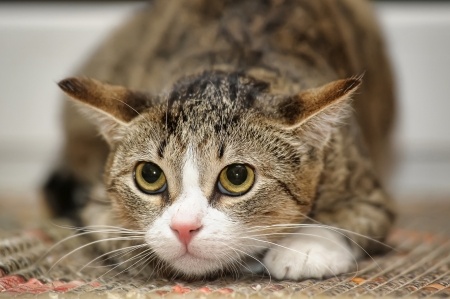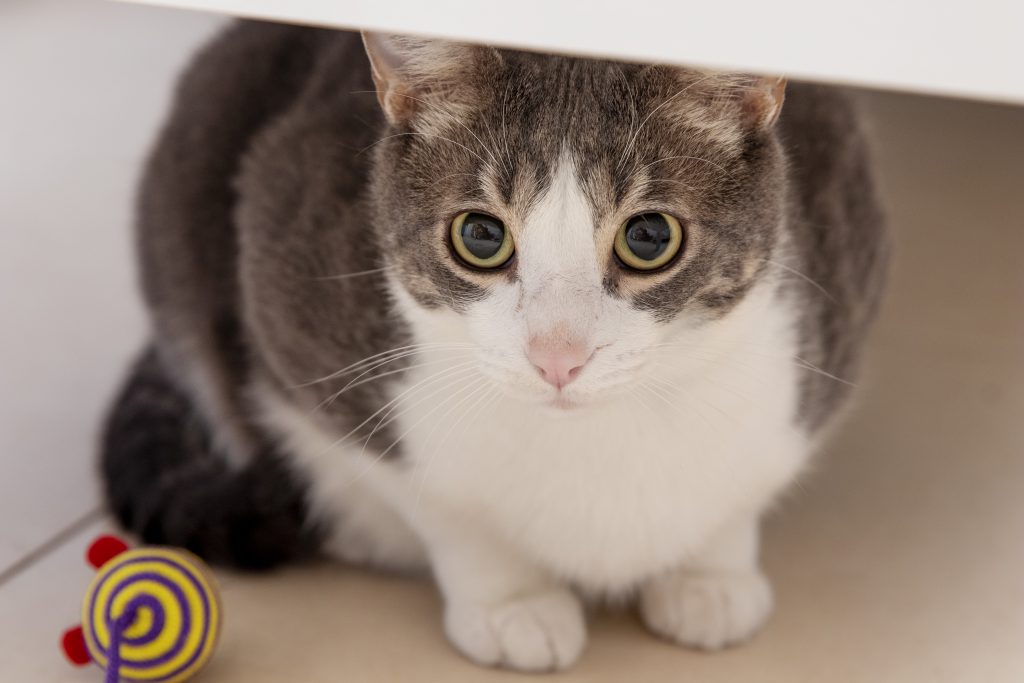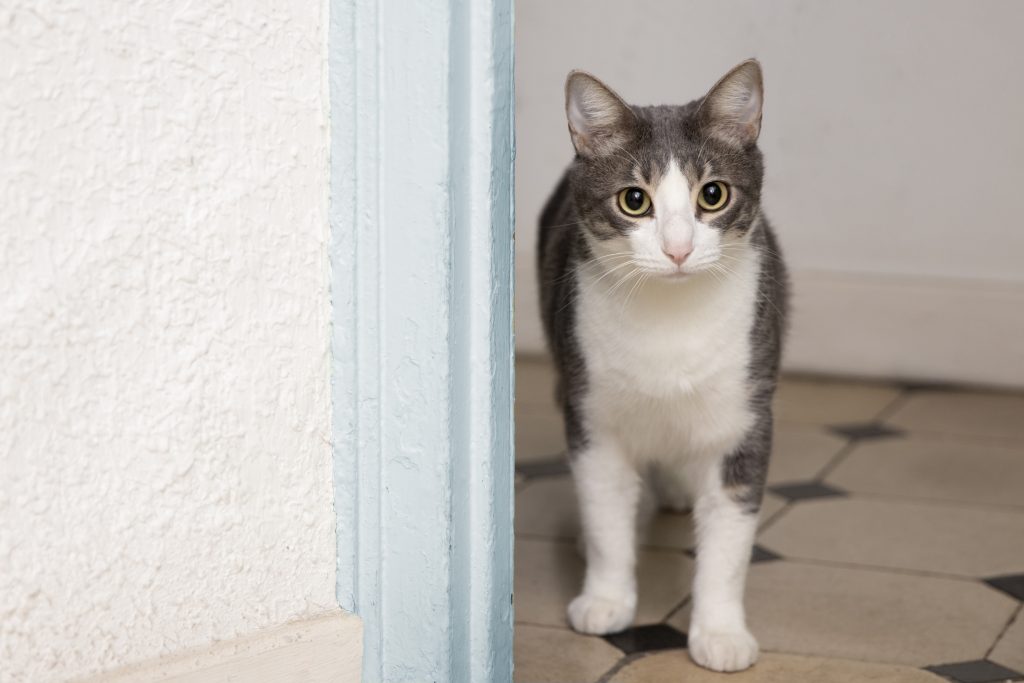Barks Blog
Working With Undersocialized Kittens and Cats
by the PPG Cat Committee
The period between 2 and 7 weeks, often referred to as the sensitive period for socialization, is a crucial time in a kitten’s social development. During these weeks, kittens are particularly open to new experiences, which makes it the ideal time for them to learn about their environment, build trust with humans, and interact positively with other animals. Kittens who experience positive interactions during this period are more likely to adapt well to new situations later in life.
Although this early window is an especially good time for shaping behavior, socialization is not limited to these weeks. With time, patience, and the right techniques, socialization can occur at any age. Consistency, positive reinforcement, and creating a safe, stress-free environment are key to helping kittens and cats overcome fear.
How Do You Know If a Cat or Kitten Needs to Be Socialized?
Understanding a cat’s body language and behavior is essential for determining whether the cat needs additional support to become more socialized and comfortable with human presence and contact. Cats communicate through both subtle and not-so-subtle physical cues and actions, which can indicate discomfort, fear, or stress.
Body Language Signals, Posture, and Movement

A cat’s body language and posture often reveal its emotional state. Key indicators of fear/anxiety/stress include:
- Pupils: dilated, may be fixed on the threat
- Ears: back or flattened, rotated toward the back of the neck
- Body: crouched, leaning away from the threat; tense, rigid posture
- Tail: tucked tail may signal fear, while quick thrashing could indicate agitation
- Eyes: closed, pretending to sleep (also a displacement behavior)
- Freezing: cat remains still and motionless, dull response to outside stimuli
Distance-Increasing Behaviors
These behaviors are used by cats to create space and distance from a perceived threat or uncomfortable situation.
- Hissing, growling, swatting
- Backing away or hiding
- Running from interaction
Avoidance and Displacement Behaviors
When a cat feels stressed or anxious, it may exhibit behaviors to avoid confrontation or deflect discomfort. Simply put, a displacement behavior occurs when an animal performs a normal behavior at an inappropriate time. Displacement behaviors may include, but are not limited to:
- Grooming
- Sniffing
- Stretching
- Turning away
- Licking lips
- Yawning
Outdated, Traditional Methods of Socialization
Many traditional methods of socializing kittens and cats cause an unnecessary amount of fear and stress and do not guarantee a good outcome. The following methods are outdated and not recommended.
Flooding
Flooding is a behavior modification technique that involves exposing a kitten or cat to a feared object, situation, or stimuli at an intense and overwhelming level with the goal of eliminating the fear response. Here are some flooding examples:
- Forcing a cat with a fear of people to sit on a person’s lap while repeatedly being stroked
- Placing a cat with a fear of water in a bathtub and turning on the water until the cat stops displaying fearful behaviors
- Restraining a cat using grooming hammocks, heavy gloves, or towel wraps to just “get it done”
- Placing a fearful kitten in a crate without access to hiding spaces in a high traffic area
Flooding can backfire with cats, especially fearful or undersocialized ones. It typically triggers heightened anxiety and stress, which can lead to defensive or aggressive behaviors. Rather than becoming desensitized, a cat may become more fearful or distrustful, damaging the potential for a positive bond.
Using Food as a Lure
Kittens have insatiable appetites, and one outdated method of socialization leverages this by using food to encourage interaction, sometimes limiting the kitten’s choices in the process. This approach forces the kitten to be touched and to share its space while eating in the hope that the kitten will associate food with positive interactions with people. Here’s an example:
- Withholding a meal to ensure the kitten is hungry enough to interact with a person. Food is then placed near the person, encouraging the kitten to come out of hiding. If the kitten comes out to eat, the person then attempts to make physical contact. If the kitten backs away, the food is removed, forcing the kitten to remain close and tolerate touch due to hunger.
If any cat feels tricked or pressured by food, it may become wary of both the food and the person offering it. This approach can create more distrust, as the cat may feel its space and boundaries are not being respected.
Scruffing
Scruffing involves firmly grasping the loose skin on the back of a cat’s neck in an attempt to help calm or restrain the cat. Scruffing adult cats is very stressful for them and can be perceived as a threat, leading to a fear response. Some examples of situations where scruffing is often used include:
- Restraining a kitten or cat to avoid human injury during interactions
- Forcing a kitten or cat to stay in a situation
- Pulling a kitten or cat out of a hiding spot
Being in control is crucial in building trust with undersocialized cats, and scruffing limits the cat’s sense of control of a situation. Scruffing can provoke defensive behaviors and damage trust, making future interactions more challenging.
All of the above outdated methods have negative consequences and should never be used to socialize or train kittens and cats.
Creating a Safe Space for a Fearful Cat or Kitten
Helping a fearful cat or kitten feel secure is essential for building trust and reducing anxiety. Creating a safe, comfortable environment tailored to the cat’s needs helps reduce stress and promote confidence. Here are key tips for setting up a comforting space:
- Designate a separate room for the cat: Set up a quiet, secure space away from other people and pets, ensuring it’s cat-proofed by covering vents, clearing shelves, and removing hazards.
- Provide hiding spots: Offer safe and accessible hiding places like boxes, tunnels, paper bags without handles, or carriers to help the cat feel secure. Block off hiding spaces that don’t allow access to the cat in case of emergency, such as spaces underneath furniture like couches or beds.
- Respect the cat’s sense of smell: Use tools like Feliway diffusers, minimize strong scents (e.g., perfumes or smoke), and avoid frequently changing the cat’s bedding to provide a sense of familiarity and security.
- Provide vertical space and scratch-friendly areas: Provide high places like cat trees for climbing, and offer various scratching surfaces with different substrates to fulfill the cat’s natural instincts.
- Establish a routine: Maintain a consistent daily schedule for feeding, cleaning, interaction, and play involving plenty of enrichment activities to help reduce stress and build confidence.
Reward-Based and Low-Stress Socialization Methods

Positive Reinforcement
Positive reinforcement is a behavior modification technique that involves providing a reward or desirable consequence to increase the likelihood of the behavior happening again. Reinforcers that can be used in positive-reinforcement training include treats, praise, affection, and play. Here are some examples of using positive reinforcement to help socialize a kitten:
- If the kitten makes eye contact with you, give it a treat.
- If the kitten shifts its body toward you, play with it with a toy for 30 seconds.
Removal of Aversive Stimuli
This method involves removing unpleasant stimuli to reinforce a behavior, increasing the likelihood that the behavior will be repeated. This method works best for cats who are too nervous to accept food from or play with a toy with a human, which makes training using positive reinforcement difficult. With these cats, we can instead reward signs of relaxation by giving them space. In other words, removing the unpleasant stimulus (you!) will increase the likelihood of the cat displaying calm body language around people in the future. Here’s an example:
- A kitten hisses when a person enters the room. The person waits quietly for the kitten to offer any sign of relaxation (blinking, releasing muscle tension, etc.), then marks the behavior with a soft “yes” and exits the room. The kitten learns that relaxing makes the person leave.
Be sure to exercise caution when adding aversive stimuli to prevent exacerbating the kitten’s fear or anxiety. Overwhelming the kitten with excessive aversive stimuli can hinder progress and lead to increased fear or aggression. Always prioritize the kitten’s comfort, and use gradual, incremental steps to build its confidence. For example:
- Avoid sudden movements or loud noises that might overwhelm the kitten.
- Respect the kitten’s comfort zone by keeping a reasonable distance.
- Watch for stress signals (e.g., hissing, growling, flattened ears, hiding) and adjust your approach as necessary.
This method should be complemented by a strong foundation of positive reinforcement to ensure behavior modification is effective:

- When the kitten shows relaxed behavior more consistently (e.g., blinking, soft body posture), it may be ready to transition to using positive reinforcement.
- Begin associating these moments of relaxation with positive reinforcement by gradually decreasing reliance on leaving the room (or otherwise removing the aversive stimulus) as a reward. Instead, reward calm behavior with treats and play with toys while staying nearby.
- Reward desired behaviors like the kitten approaching you or making eye contact, and gradually increase the level of engagement with the kitten.
- Adjust the pace of progress based on the kitten’s comfort, always prioritizing positive associations and building trust.
Interactive Play
Interactive play involves engaging a cat in activities that mimic hunting behaviors using toys to stimulate their natural instincts to stalk, chase, pounce, and catch. It can help build trust and a bond between a cat and a person. Every cat is an individual, and each cat has its own preferences, so it is important to pay attention to what the cat enjoys and feels comfortable with at the time. Here are some tips for interactive play with fearful kittens and cats:
- Avoid making large gestures with the toy. Instead, place the toy close to where the kitten feels comfortable, and move it slowly along the ground in a nonthreatening way to encourage interaction. Even if the kitten only watches, it is still engaging positively with you.
- Observe what type of “prey” the kitten or cat prefers. This could be a toy that resembles a bug crawling, a bird flying, or even one that slithers like a snake. Once you’ve identified a preferred toy, mimic the natural movements of this “prey” to encourage the cat’s instinctive hunting behaviors.
Cognitive Enrichment
With undersocialized kittens and cats, the movement of an interactive toy might be overwhelming for them, and they may retreat instead of engaging. In such cases, placing enrichment items in the environment for the kitten or cat to explore while a person sits quietly in the room can create a positive association with the person. Some ideas for combining socialization, play, and cognitive enrichment are:
- Puzzle feeders
- Obstacle course
- Treat and or scent trails using catnip or silvervine
- Sound and sensory toys
- Clicker and target training
- Vertical space (to help create a sense of security)
Timeline
Socializing a kitten or cat, particularly a fearful one, is a gradual process that varies depending on the cat’s temperament, age, and past experiences. While it may take weeks or months before some undersocialized cats fully adjust, other cats might never become as outgoing as their well-socialized counterparts. The key is to honor each cat’s unique personality and focus on creating gradual, positive interactions to build trust and foster a sense of security.
This information is also available as a handout that you can download and share.

